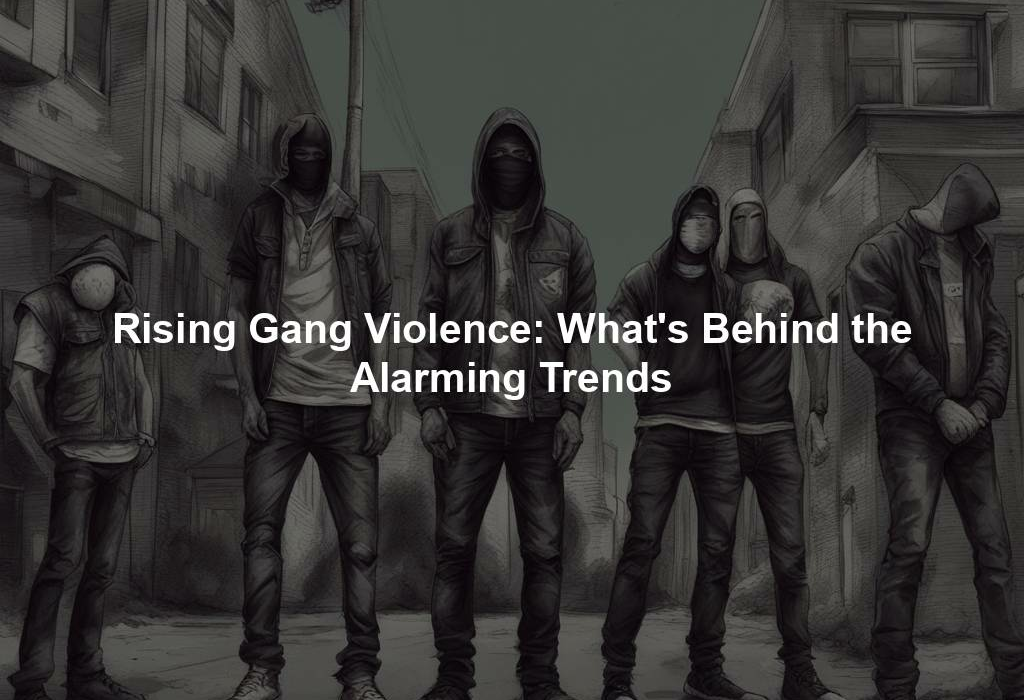Rising Gang Violence: Uncovering the Human Stories Behind the Alarming Trends
Gang violence has long been a pervasive issue in many communities around the world, but recent trends show a notable increase in gang-related incidents in various cities and regions. This alarming rise in gang violence begs the question: what factors are contributing to this uptick in criminal activity, and what can be done to address this concerning trend?
The Emotional Core:
The central emotion evoked by this surge in gang violence is fear. Fear for the safety of individuals, families, and communities. Fear of the unknown and the pervasive impact of violence.
The Human Impact:
Behind the statistical data are real lives affected by gang violence. Families torn apart by loss, communities living in constant fear, and individuals trapped in a cycle of violence. The human toll of gang violence is often overlooked, but it is essential to recognize and understand the emotional and psychological scars it leaves behind.
The Scope of the Issue
To fully understand the magnitude of the issue, it is essential to look at the data surrounding gang violence. According to a report by the National Gang Center, there are approximately 33,000 gangs operating in the United States alone, with an estimated 1.4 million members. These gangs are responsible for a wide range of criminal activities, including drug trafficking, extortion, and violent crimes.
In recent years, there has been a noticeable increase in gang-related violence across the country. According to the FBI’s 2020 Crime in the United States report, there were over 17,000 gang-related homicides in 2019, representing a 6% increase from the previous year. This surge in gang violence has sparked concern among law enforcement agencies, community leaders, and policymakers alike.
Factors Contributing to the Rise in Gang Violence
Several factors are believed to contribute to the increase in gang violence seen in recent years. One prominent factor is economic instability. Studies have shown that economic downturns and high unemployment rates can lead to an increase in gang activity as individuals seek alternative means of income.
Furthermore, the proliferation of social media and the internet has made it easier for gangs to recruit new members and communicate with one another. Many gangs use social media platforms to promote their activities, recruit new members, and even intimidate rivals. This connectivity has made it easier for gangs to expand their operations and reach a wider audience.
Additionally, the availability of firearms in many communities has been cited as a contributing factor to the rise in gang violence. Easy access to guns makes it easier for gang members to carry out violent crimes, leading to an increase in shootings and homicides.
The Impact on Communities
The impact of gang violence extends far beyond the individuals directly involved in gang activity. Communities that experience high levels of gang violence often face increased fear, decreased property values, and a breakdown of social cohesion. Residents may feel unsafe in their own neighborhoods, leading to a decrease in overall quality of life.
Furthermore, gang violence can have a detrimental impact on local businesses and economic development. High crime rates can deter investment and economic growth, hindering the prosperity of the community as a whole. This negative cycle of violence and poverty can perpetuate itself, making it even more challenging to address the root causes of gang violence.
Addressing the Issue
Efforts to address the rise in gang violence must be multifaceted and involve collaboration between law enforcement, community organizations, and policymakers. One key component of addressing gang violence is investing in community-based programs that provide at-risk youth with positive alternatives to gang involvement.
Mentorship programs, after-school activities, and job training initiatives can help steer young people away from gangs and towards productive and fulfilling futures. By empowering youth with the skills and resources they need to succeed, communities can create a more resilient and cohesive environment that is less susceptible to gang recruitment.
Law enforcement agencies also play a crucial role in addressing gang violence. By targeting gang hotspots, disrupting criminal operations, and collaborating with community partners, police can work to dismantle gang networks and reduce the impact of gang-related crime on communities. Additionally, efforts to reduce the availability of firearms and address underlying economic factors can help mitigate the root causes of gang violence.
Conclusion
The rise in gang violence is a complex and multifaceted issue that requires a comprehensive and coordinated response. By addressing the underlying factors contributing to gang activity, investing in prevention and intervention programs, and working collaboratively with community partners, law enforcement can make significant strides in reducing gang violence and creating safer and more vibrant communities for all residents.
While the challenges posed by gang violence are significant, they are not insurmountable. By taking a proactive and holistic approach to addressing the issue, communities can work towards a future free from the grip of gang violence and its devastating impact on society as a whole.




